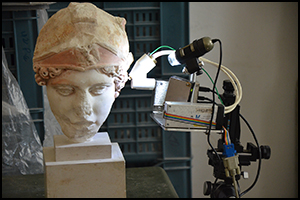Crossref Citations
This article has been cited by the following publications. This list is generated based on data provided by
Crossref.
Alfeld, Matthias
Mulliez, Maud
Devogelaere, Jonathan
de Viguerie, Laurence
Jockey, Philippe
and
Walter, Philippe
2018.
MA-XRF and hyperspectral reflectance imaging for visualizing traces of antique polychromy on the Frieze of the Siphnian Treasury.
Microchemical Journal,
Vol. 141,
Issue. ,
p.
395.
Alfeld, Matthias
Baraldi, Cecilia
Gamberini, Maria Cristina
and
Walter, Philippe
2019.
Investigation of the pigment use in the Tomb of the Reliefs and other tombs in the Etruscan Banditaccia Necropolis.
X-Ray Spectrometry,
Vol. 48,
Issue. 4,
p.
262.
Kostomitsopoulou Marketou, Ariadne
Kouzeli, Kelly
and
Facorellis, Yorgos
2019.
Colourful earth: Iron-containing pigments from the Hellenistic pigment production site of the ancient agora of Kos (Greece).
Journal of Archaeological Science: Reports,
Vol. 26,
Issue. ,
p.
101843.
Abramitis, Dorothy H.
and
Abbe, Mark B.
2019.
A group of painted funerary monuments from Hellenistic Alexandria in the Metropolitan Museum of Art.
Technè,
Vol. 48,
Issue. ,
p.
60.
Tarquini, O.
Pronti, L.
Lorenzetti, E.G.
and
Felici, Anna Candida
2020.
Pigment identification on Campana reliefs from the Palatine Hill and Colosseum Valley in Rome.
Journal of Cultural Heritage,
Vol. 43,
Issue. ,
p.
294.
Caggiani, Maria Cristina
Coccato, Alessia
Mazzoleni, Paolo
D’Alessio, Alessandro
Russo, Alfonsina
and
Barone, Germana
2020.
Integrated analytical approach to unveil the secrets of the recently discovered “Sphinx Room”: a new piece of Domus Aurea puzzle.
Heritage Science,
Vol. 8,
Issue. 1,
Green, George Alexander
Ishida, Katsu
Hampshire, Bethany V.
Butcher, Kevin
Pollard, A.Mark
and
Hillier, Adrian D.
2021.
Understanding Roman Gold Coinage Inside Out.
Journal of Archaeological Science,
Vol. 134,
Issue. ,
p.
105470.
Neri, Elisabetta
Nasr, Nesrine
and
Strivay, David
2022.
Ancient Restoration in Roman Polychromy: Detecting Aesthetic Changes?.
Heritage,
Vol. 5,
Issue. 2,
p.
829.
Brøns, Cecilie
Stenger, Jens
Bredal-Jørgensen, Jørn
Di Gianvincenzo, Fabiana
and
Brandt, Luise Ørsted
2022.
Palmyrene Polychromy: Investigations of Funerary Portraits from Palmyra in the Collections of the Ny Carlsberg Glyptotek, Copenhagen.
Heritage,
Vol. 5,
Issue. 2,
p.
1199.
Neri, Elisabetta
Alfeld, Matthias
Nasr, Nesrine
de Viguerie, Laurence
and
Walter, Philippe
2022.
Unveiling the paint stratigraphy and technique of Roman African polychrome statues.
Archaeological and Anthropological Sciences,
Vol. 14,
Issue. 6,
Liverani, Paolo
Bracci, Susanna
Iannaccone, Roberta
Lenzi, Sara
and
Magrini, Donata
2023.
New Evidence about the Polychromy of Early Imperial Cycle from the Augusteum of Rusellae (Tuscany).
Heritage,
Vol. 6,
Issue. 4,
p.
3385.
Kakoulli, Ioanna
and
Balonis, Magdalena
2023.
Handbook of Archaeological Sciences.
p.
833.
Aggelakopoulou, Eleni
and
Bakolas, Asterios
2024.
Investigating polychromy on the Parthenon’s west metopes.
Archaeological and Anthropological Sciences,
Vol. 16,
Issue. 7,
